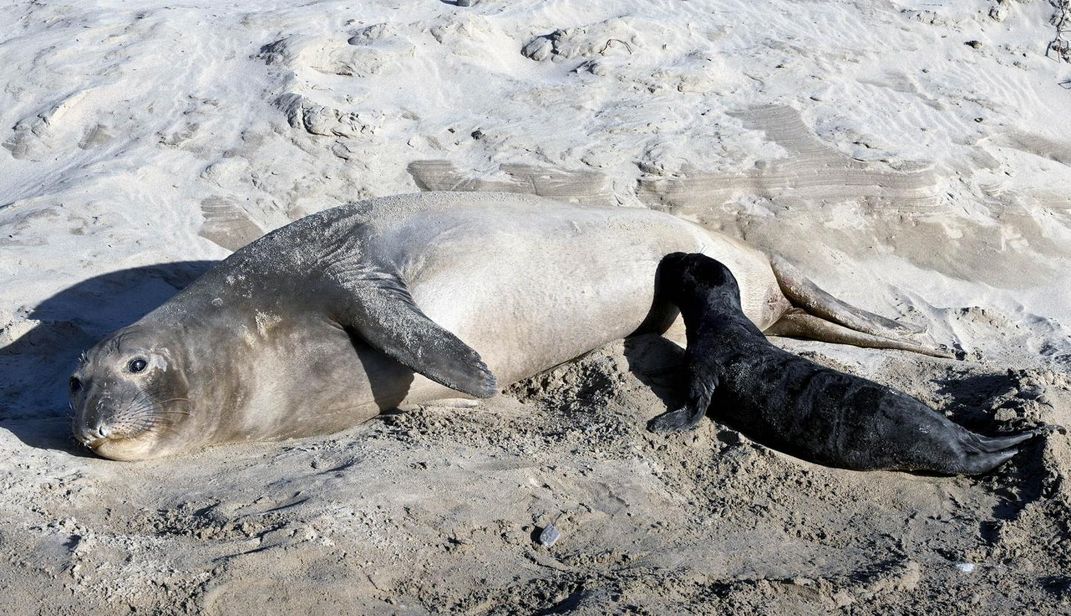Select Elephant Seal ‘Supermoms’ Produce Most Pups
The most successful seal mothers were those that ‘bred at every opportunity and lived long’
/https://tf-cmsv2-smithsonianmag-media.s3.amazonaws.com/filer/da/ce/dacef9bc-f605-48d8-8c07-d8eb3c5b6975/bulle.jpg)
A northern elephant seal colony based in California’s Año Nuevo State Park can trace the majority of its population to a select group of long-lived “supermoms.”
As researchers led by Burney Le Boeuf, an ecologist and evolutionary biologist at the University of California, Santa Cruz, report in the Canadian Journal of Zoology, a survey of 7,735 female seals found that a small number—just 6 percent—produced 55 percent of the colony’s total pup population over a roughly 50-year period.
Crucially, the team writes, the most successful seal mothers were those that “bred at every opportunity and lived long.” Per National Geographic’s Carrie Arnold, these supermoms started reproducing later than the average female, giving them an edge in terms of health, size and experience.
“It's surprising because there are so many more young females than older females, and you expect them to contribute more to the population,” Le Boeuf says in a press release. “But it doesn't work out that way, because most of them don't live very long.”
According to Marina Wang of Canadian Science Publishing, elephant seals give birth to one pup every winter. Mothers care for their babies during a four-week weaning period, but after this point, they leave the pups to fend for themselves.
Per the study, young seals spend the next two months or so learning how to swim in preparation for their first foraging trip. Many do not survive this initial venture, instead falling prey to predators such as white sharks and killer whales or starving to death following failed foraging attempts. In total, 75 percent of weaned female pups die before reproducing; of those who reach maturity, most breed just one to three times before succumbing to poor health.

Young seal mothers experience low reproductive success because giving birth and weaning one’s pup takes up energy that would otherwise bolster the still-growing juveniles’ development. As Le Boeuf tells Wang, “There’s a cost to doing that.”
National Geographic’s Arnold notes that females younger than four years old often give birth to smaller pups with lower chances of survival. These mothers, in turn, have lower body weights and are similarly likely to die young.
Supermoms, defined by the researchers as seals that give birth to ten or more pups in their lifetimes, represent a small percentage of the overall population. Still, Le Boeuf explains to Arnold, “It’s these reproducers that will determine the future of the colony.”
According to the paper, the longest-lived female tracked by the team was a 23-year-old mother of 17. Another supermom bred for 16 consecutive years, giving birth annually from ages 4 to 19.
Speaking with Arnold, Elena Salogni, a marine biologist at Newfoundland’s Memorial University who was not involved in the new research, says supermoms’ offspring tend to survive longer than babies with younger mothers. Because supermoms are “bigger and more experienced,” Salogni adds, they are better equipped to protect their pups.
La Boeuf and his colleagues—Richard Condit of Illinois’ Field Museum of Natural History and Joanne Reiter of the University of California, Santa Cruz, Institute for Marine Sciences—offer a succinct summary of supermoms’ strategies. Ultimately, they write, female seals’ reproductive success stems from living long and being pregnant or nursing for the entirety of adulthood.
“If I was asked to look at a group of elephant seals and pick out the supermoms, I don’t think I could do it,” La Boeuf tells Arnold. “[But] somehow, they pull it off.”
/https://tf-cmsv2-smithsonianmag-media.s3.amazonaws.com/accounts/headshot/mellon.png)
/https://tf-cmsv2-smithsonianmag-media.s3.amazonaws.com/accounts/headshot/mellon.png)